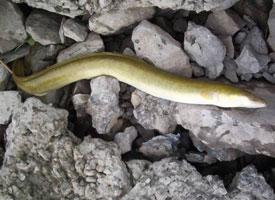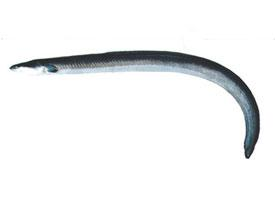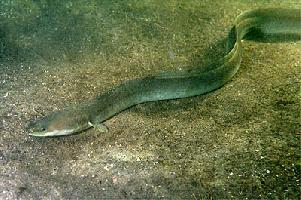
Popis zvířete
The American eel (Anguilla rostrata) is a fascinating and enigmatic creature that has captured the curiosity of scientists and nature enthusiasts alike. This species of eel is unique not only in its wide geographical range but also in its complex life cycle and behaviors. The American eel is native to the Atlantic coast of North America, ranging from Greenland in the north, down to the Caribbean, and as far south as Venezuela in South America. It inhabits a variety of aquatic environments, including rivers, lakes, estuaries, and even small streams, showcasing an incredible adaptability to different habitats.Adult American eels are generally dark green, brown, or black on their backs and sides, gradually fading to a lighter yellow or green on their bellies, which provides them with excellent camouflage in their murky aquatic environments. They can grow quite large, with females typically reaching lengths of up to 4 feet (1.2 meters), while males are usually smaller, averaging around 2 feet (0.6 meters) in length. Their elongated, snake-like bodies are equipped with a continuous dorsal fin that extends from the middle of the back to the tail, merging with a similarly structured anal fin, giving them a highly distinctive appearance and an incredible ability to navigate and maneuver through water.
One of the most remarkable aspects of the American eel's life is its reproductive journey, which remains shrouded in mystery and intrigue. Unlike many other migratory species, American eels spawn only once in their lifetime, at the end of their lives. They undertake a long and perilous migration from their freshwater or coastal habitats to the Sargasso Sea, a region in the North Atlantic Ocean, to spawn. The exact location and process of their spawning are still not fully understood, as no one has ever observed it in the wild. It is believed that after spawning, the adult eels die, leaving their offspring to make the journey back to North American waters.
The larvae of the American eel, known as leptocephali, are transparent and leaf-shaped, drifting with the ocean currents for several months before transforming into glass eels and then elvers as they approach the continental shelf. Once they reach the coastal and freshwater environments, they begin to mature into the adult form, a process that can take from 6 to 20 years, depending on environmental conditions.
Despite their wide distribution and once-abundant numbers, American eel populations have been experiencing significant declines due to a combination of factors, including habitat loss, pollution, barriers to migration such as dams and culverts, overfishing, and climate change. These challenges have led to increased conservation efforts to understand and protect this mysterious and vital species, emphasizing the importance of maintaining the health and connectivity of their aquatic habitats.
The American eel plays a crucial role in its ecosystem, acting as both predator and prey. It feeds on a variety of organisms, including insects, smaller fish, crustaceans, and worms, but it also falls prey to larger fish, birds, and humans. In some regions, eels are considered a delicacy and have significant cultural and economic value, further highlighting the need for sustainable management practices.
In summary, the American eel (Anguilla rostrata) is a species of great intrigue and importance. Its complex life cycle, broad geographic range, and ecological roles make it a subject of ongoing research and conservation efforts. As we continue to unravel the mysteries of its life and strive to protect its populations, the American eel remains a symbol of the interconnectedness and fragility of aquatic ecosystems.
Podobná zvířata
Nové fotografie zvířat
Top 10 zvířat
- Chinese water dragon (Physignathus cocincinus)
- Galápagos tortoise (Geochelone nigra complex)
- Dolphin gull (Leucophaeus scoresbii)
- Japanese macaque (Macaca fuscata)
- Colombian red howler (Alouatta seniculus)
- Sea urchins (Echinoidea)
- Moustached guenon (Cercopithecus cephus)
- Diana monkey (Cercopithecus diana)
- Common reed warbler (Acrocephalus scirpaceus)
- Common house mosquito (Culex pipiens)

